Last Updated on: September 1, 2025Choosing the right color-changing floodlight can feel confusing. If you get it wrong, your project’s lighting can look cheap and disappointing, failing to create the desired effect for your client.
The main difference is the dedicated white chip. RGBW adds a separate white LED to the red, green, and blue ones. This creates a much purer, brighter white light and a wider range of colors than you can get from a standard RGB fixture alone.
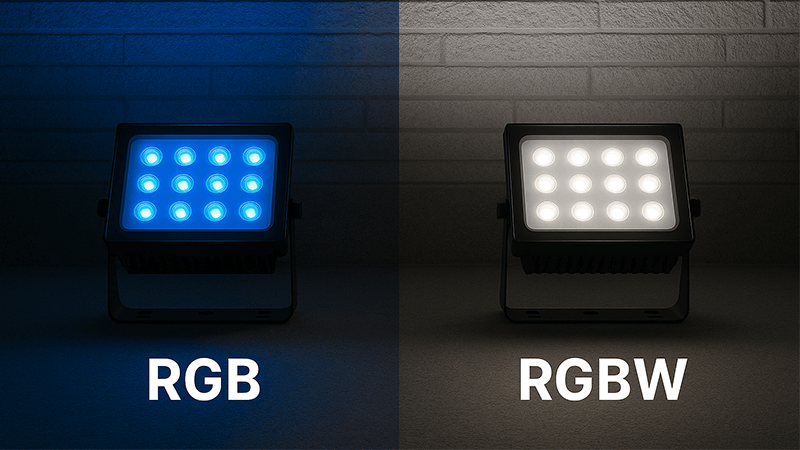
I’ve been in the LED lighting business for a long time, starting on the factory floor and now running my own manufacturing company. I’ve seen firsthand how a small detail, like the choice between RGB and RGBW, can make or break a large-scale project. A purchasing manager like you, Shaz, knows that getting the specs right from the start saves time, money, and protects your reputation. You need to deliver quality that matches the vision. Let’s break down these differences so you can make the best choice every time and ensure your projects shine exactly as intended.
Which is better, RGB or RGBW?
You’re specifying lights for a high-end hotel facade. Choosing the wrong type could mean weak colors and an off-looking white light, making a premium building look unprofessional and disappointing your client.
For almost all professional outdoor lighting projects, RGBW is better. It provides a true, functional white light for general illumination and a much wider range of pastel colors, making it far more versatile.
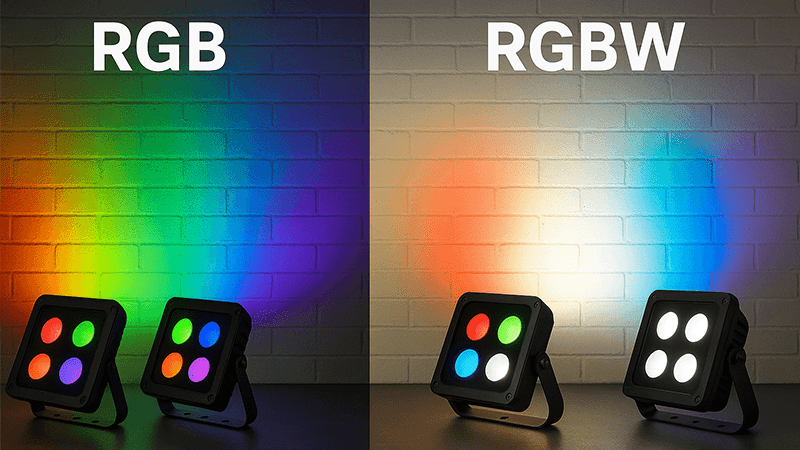
When we talk about which is "better," we’re really talking about versatility and quality. An RGB floodlight creates white light by mixing Red, Green, and Blue light at their highest intensity. The result is what we in the industry call "composite white." Frankly, it’s not great. It often has a noticeable blue or pink tint and just doesn’t look clean. For a project where you might need to switch from a colorful display to standard, functional white light, RGB simply falls short.
This is where the "W" in RGBW makes all the difference. That ‘W’ stands for a dedicated white LED chip built right into the fixture alongside the red, green, and blue ones. When you need white light, the fixture uses this specific chip. This gives you a pure, crisp white light that is brighter and much more energy-efficient than trying to mix it from three different colors. I remember a project for a resort in Dubai. The client initially wanted RGB to save a little on the budget. I sent samples of both. Once they saw the weak, bluish "white" of the RGB next to the brilliant, clean white of the RGBW, the decision was instant. They understood that the small extra cost for RGBW protected the entire project’s premium feel. For a purchasing expert like you, recommending RGBW is recommending a more professional and flexible solution.
| Feature |
RGB Floodlight |
RGBW Floodlight |
| White Light Quality |
Composite, often bluish/pinkish, low CRI |
Pure, crisp white from a dedicated chip, higher CRI |
| Color Range |
Saturated primary and secondary colors |
Same saturated colors plus a wide range of pastel shades |
| Energy Efficiency |
Less efficient when producing white light |
More efficient when producing white light |
| Best Use Case |
Situations needing only basic color effects |
Projects needing both vibrant color and high-quality white light |
What is the best LED color for outdoor lights?
Picking the right color for an outdoor space is critical. The wrong choice can ruin the mood, reduce security, or simply look out of place, reflecting poorly on the entire project’s design.
The best color depends entirely on the goal. Warm white (2700K-3000K) is perfect for creating a cozy, inviting atmosphere. Cool white (4000K-5000K) is better for security and task areas. RGB/RGBW offers the ultimate flexibility for any mood or event.
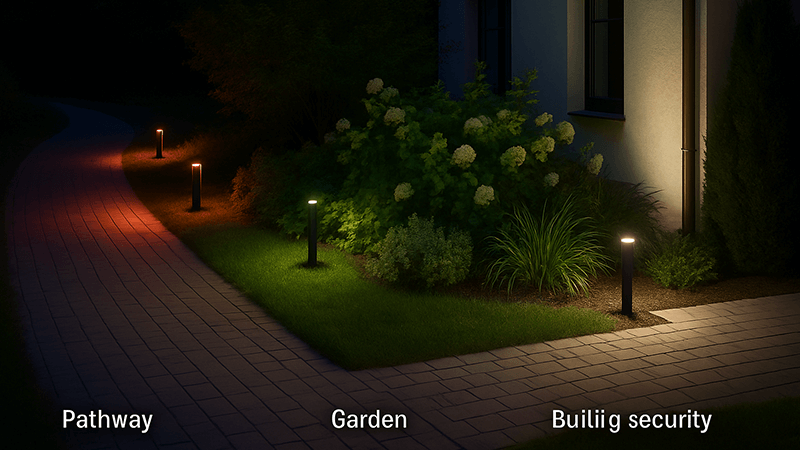
There is no single "best" color; there is only the best color for a specific application. It’s my job to help clients understand this distinction. For example, if you are lighting pathways at a luxury resort, a warm white light of around 3000K is ideal. It feels soft, welcoming, and high-end. It makes guests feel comfortable and safe. Using a harsh, 5000K cool white in that same space would make it feel like a hospital or a warehouse—completely wrong for the environment.
On the other hand, for a commercial building’s parking lot or loading dock, that 5000K cool white is the perfect choice. It enhances visibility, makes colors appear true for security cameras, and promotes alertness. This is where we need to understand the science. A standard white LED is made from a blue LED chip coated in a yellow phosphor. This combination creates a full, continuous spectrum of light, which is why it renders colors so well. When you need fixed, reliable illumination, a dedicated single-color LED is often the most efficient choice. But when a space needs to serve multiple purposes—like a public square that needs clear, bright light for general use but also wants to be lit up in festive colors for a holiday—that’s when RGBW becomes the best choice. It gives you both options without compromise.
| Outdoor Area |
Recommended Color/CCT |
Why? |
| Gardens & Landscape |
2700K–3000K (Warm White) |
Accentuates greens and natural tones, creates a relaxing mood. |
| Building Facades |
3000K–4000K or RGBW |
3000K for classic stone, 4000K for modern metal, RGBW for dynamic effects. |
| Pathways & Patios |
3000K (Warm White) |
Creates a safe but comfortable and welcoming ambiance. |
| Parking & Security |
4000K–5000K (Cool White) |
Improves visibility, alertness, and clarity for security cameras. |
Which is better, RGB or LED lights?
Some in the industry use these terms interchangeably, which creates confusion. If you order based on this misunderstanding, you could end up with a product that completely misses your project’s requirements.
This question is based on a common confusion. RGB is a type of LED light. The real choice is between single-color LED lights and color-changing RGB/RGBW LED lights. Neither is "better"; they simply serve different purposes.
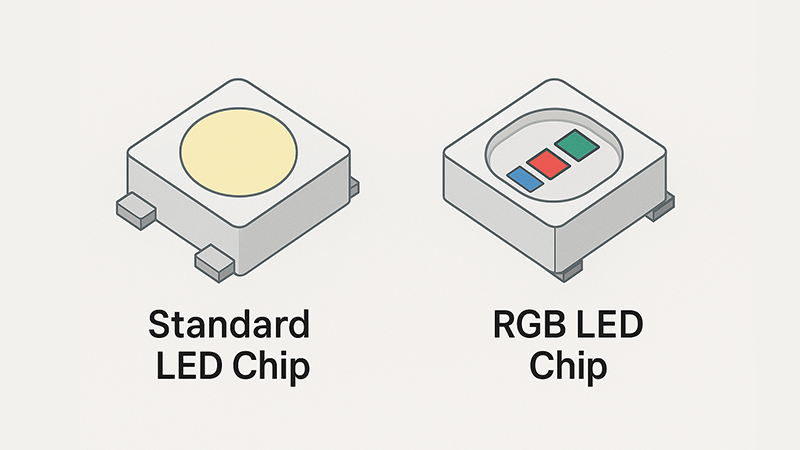
Let’s clear this up, as it’s a fundamental point I always stress with my partners. "LED light" is the core technology—the light-emitting diode itself. An RGB light is simply an LED fixture that contains three types of these diodes: Red, Green, and Blue. So, an RGB light is an LED light. The better question to ask is, "When should I use a single-color LED light, and when should I use a color-changing RGB/RGBW light?"
A single-color LED floodlight is a specialist. It is designed and optimized for one thing: to produce a specific color of white (like 3000K warm white or 4000K neutral white) as brightly and efficiently as possible. All of its components, from the chip to the lens to the heat sink, are engineered for that single purpose. In contrast, an RGB/RGBW floodlight is a generalist. It is designed for versatility. Its main purpose is to give you a toolbox of colors. While it can produce white light, its core design is focused on color mixing and control.
This is where quality control, something I am passionate about, becomes critical. We sort our LED chips into "BINs" based on tiny variations in color and brightness. For a large project with single-color white lights, I ensure every single light uses chips from the exact same BIN. This guarantees perfect consistency across the whole installation. No one light will look slightly warmer or cooler than its neighbor. The same principle applies to high-quality RGBW lights. Cheaper manufacturers often mix BINs to cut costs, which is why you can sometimes see color variations even between two brand-new lights. For a purchasing manager who values reliability, specifying products made with same-BIN chips is a non-negotiable quality marker.
What is the difference between RGBW and RGB white lights?
You have specified color-changing lights for a project, and you need a clean white light option. The "white" from your standard RGB fixture looks tinted and weak, and your client is not happy.
The difference is how the white light is created. "RGB white" is a low-quality, composite light made by mixing red, green, and blue. RGBW uses a dedicated, separate white LED chip that produces a pure, efficient, and high-quality white light.
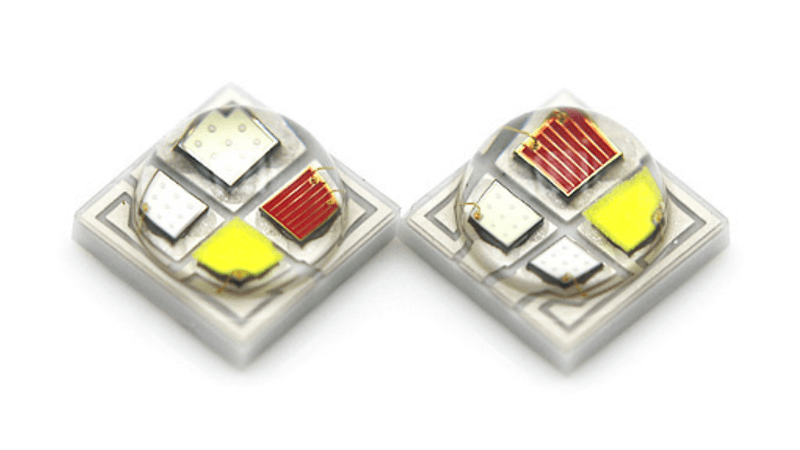
This is the most important technical difference, and understanding it is key to specifying the right product. An RGB fixture is limited by its color-mixing triangle. Think of it like a painter with only red, green, and blue paint. They can mix many colors, but getting a truly pure white is impossible; it will always be a muddy approximation. In lighting, this "RGB white" is made by running the red, green, and blue diodes at full power. The resulting light has a poor Color Rendering Index (CRI), meaning it makes objects look unnatural. It’s also often visibly tinted.
The RGBW fixture solves this problem elegantly. It adds a fourth chip—a pure white one—to the mix. This white chip is typically a cool white, around 6000K-7000K, created with the standard blue-chip-and-yellow-phosphor method. This means it has a good, continuous light spectrum. When you need white, this is the chip that turns on. The result is a clean, bright, and true white light that is far superior to the composite white from an RGB fixture. This is not just about aesthetics; it is also about efficiency. Powering one white chip is much more efficient than powering three color chips at maximum brightness. For advanced applications, you might even see RGBWW or RGBCCT fixtures. These include two dedicated white chips—one warm white and one cool white. This gives you complete control over the white light color temperature, from a very warm 2700K to a very cool 6500K, all while maintaining high quality and efficiency. As a buyer for diverse projects in the UAE, having this level of control can be a massive advantage.
| Light Source |
How White is Made |
Resulting White Light Quality |
| RGB |
Mixing Red + Green + Blue at 100% |
Low CRI, often tinted (blue/pink), inefficient, "composite" |
| RGBW |
Activating a dedicated White LED chip |
High CRI, pure white color, efficient, "true" white |
Conclusion
For outdoor lighting that requires both vibrant colors and functional, high-quality white light, RGBW is the clear winner over standard RGB, offering greater versatility, efficiency, and a more professional result.